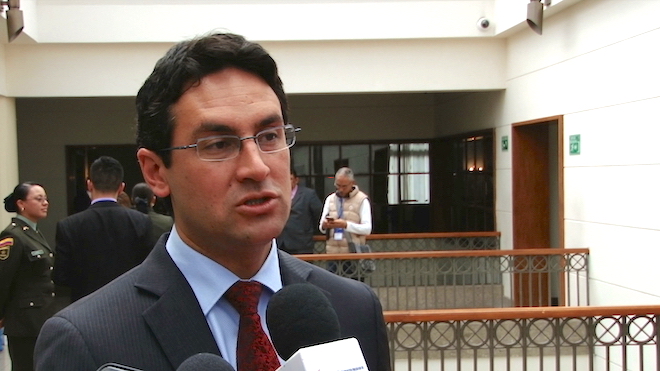Interview with Camilo Enciso, former Colombian Secretary for Transparency on developing a High-Level Reporting Mechanism for Peru

Below is an interview with Mr. Camilo Alberto Enciso Vanegas, former Secretary for Transparency of the Presidency of the Republic of Colombia and international anti-corruption expert, who visited Peru on behalf of the Basel Institute on Governance (BIG) and the Organization for Economic Cooperation and Development (OECD) in August and October 2017 to support efforts to adopt a High Level Reporting Mechanism (HLRM) in the country.
The expert missions were supported by Peru’s High Level Anti-Corruption Commission (CAN) and the Basel Institute on Governance’s Peru country office. It involved high-level meetings with key stakeholders of the procurement system.
High Level Reporting Mechanisms seek to prevent bribery in public procurement, or other forms of corruption through innovative and strategic collaboration between the public and the private sectors. An HLRM is a reporting channel that companies can use to report issues that might lead to favoritism of a particular bidder or other forms of unfair treatment including indications of bribery solicitation that might occur during a procurement tender. The HLRM is designed to provide a prompt and swift resolution of such allegations. It substantially reduces collusion risks and aims to prevent the suspension of the procurement process, it also seeks to prevent retaliation against companies and business losses.
Ultimately, an HLRM aims to benefit citizens, by promoting the implementation of major public works with transparency and the efficient use of public resources.
The following comments on efforts to adapt the HLRM model for Peru, drawing in part on the Colombian experience, has been adapted from a Spanish version of an interview with Mr. Enciso.
How has the High-Level Reporting Mechanism been implemented in Colombia?
Latin American countries face great challenges as a result of particularly serious and emblematic grand corruption cases, which have led to lack of public trust and have revealed poor institutional capacity to timely process corruption allegations. The High-level Reporting Mechanism intends to provide a channel for prompt and timely reporting, which will help solve corruption risks and problems that are currently being found in government procurement processes, licensing procedures or administrative actions of great relevance.
In Colombia, the HLRM was implemented in fourth generation infrastructure projects, i.e. road infrastructure projects with a high level of government investment. More than 14 fourth generation road projects were developed, for which we invited pre-qualified companies to sign a MoU. Through this, companies agreed, first, to fair competition and to act in good faith; and, second, to report potential corruption concerns that may have arisen in the course of the tender processes to the HLRM
During your expert missions you have held meetings with important Peruvian authorities. Could you give us an overall appreciation on how you perceive their commitment with anti-corruption efforts?
The Peruvian public administration has shown a great deal of commitment by supporting the implementation of this mechanism. We are defining more precisely which agency will be competent to host and implement the HLRM. Moreover, we are observing which would be the projects or types of agreements around which it might operate because the HLRM is not suitable for all business transactions. A phased approach is encouraged, which will first focus on projects of a high strategic value and of high cost, which are particularly relevant for the economic development of Peru. For instance, the HLRM could work for road infrastructure projects, in the metro system building process, in the aqueduct construction works or works of similar relevance.
Northern Peru is going through a critical process after recent natural disasters have destroyed a great part of available infrastructure. Is there a similar Colombian experience you could tell us about, which could serve as an example for rebuilding works to be developed in Peru?
We are also exploring the idea of incorporating the HLRM in some agreements to be entered into for rebuilding northern Peru. There is a very interesting experience in Colombia, which resulted from the “cold wave” of 2011. This phenomenon destroyed dozens of towns in the country, which received a very significant injection of resources from the government to build roads, bridges and highways, renew crops, rebuild houses and schools, something very similar to what is currently going on in the towns of northern Peru.
In this case, efforts were made to establish clear rules that allowed a prompt investment of resources ensuring full transparency and integrity, thus succeeding at preventing corruption practices, even though multi-million resources were invested. This was a great challenge and a very valuable experience.
The OECD is a key stakeholder in the fight against corruption. What was the role it played in Colombia and what would be its role in Peru?
In Colombia, the process of OECD accession was a priority because it demonstrated the government’s commitment to meet the highest international standards on good governance. The OECD has two working groups of great relevance: the Working Group on Bribery and the Public Governance Committee. Throughout the Colombia OECD accession process, in which I participated as one of Colombia’s representatives, I led many necessary internal transformations and changes. The OECD works as a catalyser and accelerator of reform processes required by our countries.
In Peru, both the OECD and the Basel Institute on Governance will provide the necessary technical support necessary to plan, design and implement the HLRM, supporting the national agencies to achieve this goal.
The Basel Institute on Governance’s Subnational Public Financial Management Program implemented in Peru with the support of the Swiss Cooperation – SECO works to improve financial management of the public budget and transparency of institutional processes. Is there any related experience from Colombia you can tell us about?
When I worked as Colombia’s Secretary of Transparency, we implemented a program, “Educational Paths for a Culture of Integrity” to educate citizens at different stages of their lives with tailored awareness-raising activities on ethics for school students, university students, and public servants. Furthermore, we made efforts to achieve an “Open Government” understood as access to information on what the government produces and have made significant progress. Colombia’s Open Government Partnership two-year National Action Plan includes commitments by the Council of State, the highest judicial authority, which started an open information and accountability process at the national and local levels.
This plan was signed by all the heads of the governing bodies, of criminal prosecution agencies and of the anti-corruption authorities in Colombia, including the President of the Republic. Without a doubt it was a truly transformational process, which also engaged Colombian citizens.



